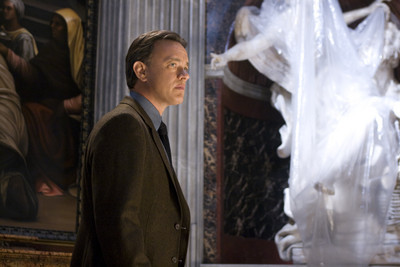‘Angels & Demons’
Consider "Angels & Demons" director Ron Howard's mea culpa for "The Da Vinci Code."
Howard's 2006 adaptation of Dan Brown's best-seller may have been a box-office smash, but it wasn't exactly what you'd call inspired filmmaking.
Pompous, ponderous, even a bit too reverent for its own good, its stately pace seemed better suited to a papal processional than a big-screen thriller.
So the good news is that Howard makes a definite bid for cinematic absolution with "Angels & Demons" -- by going in the opposite direction.
Where "Da Vinci" was convoluted and talky, "Angels & Demons" has a tick-tock, beat-the-clock structure that requires a minimum of complicated chat and a maximum of racing around trying to avert disaster.
But there's such a thing as a happy medium, and once again Howard hasn't managed to find it.
Although Brown's novel "Angels & Demons" preceded "Da Vinci Code," the filmmakers transform the tale into a sequel, thereby enabling screenwriters Akiva Goldsman (who scripted "Da Vinci Code") and David Koepp (whose credits include popcorn smashes from "Jurassic Park" to "Indiana Jones and the Kingdom of the Crystal Skull") to sidestep the tedium of actual character development.
Good thing we already know renowned symbologist Robert Langdon -- once again played by Tom Hanks, mercifully shorn of his distracting "Da Vinci Code" tresses, if not his droll sense of humor.
Robert's back at Harvard when a representative from the Vatican comes calling with an urgent request.
Due to the sudden death of a beloved (and liberal) pope, the College of Cardinals is meeting in conclave to select a new pontiff.
Except that someone has kidnapped the likeliest candidates -- and has sworn to kill them, one every hour, before setting off a cataclysmic explosion in the heart of Vatican City.
The entire chilling plot seems to signal the return of the Illuminati, an ancient, clandestine sect whose devotion to scientific truth made them automatic enemies of the Roman Catholic Church.
Some centuries later, the Illuminati seem poised to exact deadly revenge. And it's up to Robert to figure out who, what, how -- and where -- before Rome goes kablooey as thousands of faithful swarm St. Peter's Square, awaiting word of the new pope's selection.
Lest we forget, the stuff that will go kablooey if things don't work out is a spark of antimatter swiped from a Swiss supercollider. And there's a researcher from that project ("Munich's" Ayelet Zurer) on hand to help Robert stop that from happening.
A no-nonsense cop (Pierfrancesco Favino, who plays Christopher Columbus in "Night at the Museum" and its sequel, which hits theaters next week) provides able assistance, as does the late pope's young chamberlain (earnest Ewan McGregor), who's shocked, shocked, that skullduggery might be afoot in the Vatican's hallowed halls.
Not everyone's so eager to assist, however. The Vatican's taciturn security chief (crisply authoritarian Stellan Skarsg?rd) seems suspiciously uncooperative. And the cardinal presiding over the new pope's election (a wily Armin Mueller-Stahl) isn't exactly distraught that his kidnapped colleagues might not survive the next few hours.
As Robert and Co. race around Rome to connect the dots and rescue them Before It's Too Late, "Angels & Demons" makes a few half-hearted stabs at contrasting religion and science, ancient traditions and technological advances.
Most of the time, however, it's too busy zooming from one suspenseful set-up to the next to focus on such esoteric concerns.
There's just one problem with all this zooming around, however: It's never as suspenseful as it ought to be.
With its built-in countdown structure, "Angels & Demons" has an inherent forward momentum that carries it past such daunting problems as the lack of character development -- and, even worse, the lack of a compelling villain.
Howard serves up ample distraction thanks to its canny mixture of real and make-believe Rome locations.
And the director also thoughtfully provides plenty of in-your-face shockeroos as the good guys discover the bloody (and we do mean bloody) consequences of the kidnap plot and its aftermath.
Yet far too many sequences that should keep you on the edge of your seat elicit a been-there, seen-that shrug, particularly because Howard's so determined to cut to the chase -- and cut out almost everything that would make the chase mean something.
Yes, it's better than "The Da Vinci Code." But that doesn't necessarily make it good.
Contact movie critic Carol Cling at ccling@reviewjournal.com or 702-383-0272.
Carol Cling's Movie Minute
Review
"Angels & Demons"
138 minutes
PG-13; violence, disturbing images, mature themes
Grade: C+
at multiple locations
Deja View
The Roman Catholic Church has played a starring role in a wide variety of movies, from "The Song of Bernadette" to "The Sound of Music." A few other memorable examples:
"I Confess" (1953) -- In this Alfred Hitchcock-directed thriller, a priest (Montgomery Clift) becomes a murder suspect when he refuses to reveal what he's heard in the confessional.
"The Nun's Story" (1959) -- In this Oscar-nominated drama, Audrey Hepburn plays the title role of a nun whose faith and vows are continually tested, especially while working in Africa with a brilliant physician (Peter Finch).
"Becket" (1964) -- In 12th-century England, King Henry II (Peter O'Toole) appoints his best friend Thomas á Becket (Richard Burton) Archbishop of Canterbury, triggering unexpected church-vs.-state conflict.
"The Exorcist" (1973) -- Two Catholic priests (Max von Sydow, Jason Miller) try to drive out the demonic force possessing an innocent 12-year-old (Linda Blair).
"Agnes of God" (1985) -- Jane Fonda, Anne Bancroft and Meg Tilly headline this drama about the investigation of a newborn's mysterious death -- in a naive novice's convent quarters.
-- By CAROL CLING















